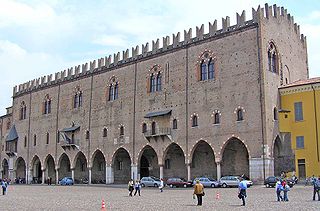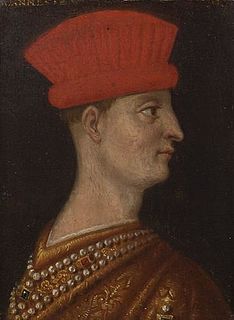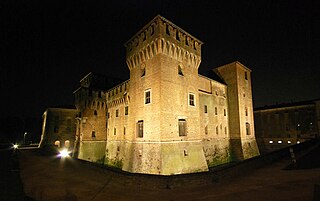Coordinates: 45°09′35″N10°47′16″E / 45.159766°N 10.787865°E

A geographic coordinate system is a coordinate system that enables every location on Earth to be specified by a set of numbers, letters or symbols. The coordinates are often chosen such that one of the numbers represents a vertical position and two or three of the numbers represent a horizontal position; alternatively, a geographic position may be expressed in a combined three-dimensional Cartesian vector. A common choice of coordinates is latitude, longitude and elevation. To specify a location on a plane requires a map projection.

The Chiesa di San Francesco ( Italian, "Church of St. Francis" ) is a Roman Catholic church located in the historic center of Mantua, Italy, at Piazza San Francesco d'Assisi 5.

Italian is a Romance language. Italian, together with Sardinian, is by most measures the closest language to Vulgar Latin of the Romance languages. Italian is an official language in Italy, Switzerland, San Marino and Vatican City. It has an official minority status in western Istria. It formerly had official status in Albania, Malta, Monaco, Montenegro (Kotor) and Greece, and is generally understood in Corsica and Savoie. It also used to be an official language in the former Italian East Africa and Italian North Africa, where it plays a significant role in various sectors. Italian is also spoken by large expatriate communities in the Americas and Australia. In spite of not existing any Italian community in their respective national territories and of not being spoken at any level, Italian is included de jure, but not de facto, between the recognized minority languages of Bosnia-Herzegovina and Romania. Many speakers of Italian are native bilinguals of both standardized Italian and other regional languages.

Mantua is a city and comune in Lombardy, Italy, and capital of the province of the same name.

Italy, officially the Italian Republic, is a country in Europe. Located in the middle of the Mediterranean Sea, Italy shares open land borders with France, Switzerland, Austria, Slovenia and the enclaved microstates San Marino and Vatican City. Italy covers an area of 301,340 km2 (116,350 sq mi) and has a largely temperate seasonal and Mediterranean climate. With around 61 million inhabitants, it is the fourth-most populous EU member state and the most populous country in Southern Europe.
The church was founded by the Franciscan Order in 1304 but it was not consecrated until 1459, when Pope Pius II performed the ceremony. [1] Suppressed in 1782, it was sacked in 1797, [1] during the Napoleonic Wars, and turned into an arsenal in 1811. Still in military use when World War II began, it was devastated by bombardment during the war. The Cappella Gonzaga, with its frescoes depicting the life of St. Louis of Toulouse ( Italian : San Ludovico d'Angiò ), was saved and recently restored. These frescoes were supposed to have been painted by Serafino de' Serafini, [1] an artist who was active in Modena during the 14th Century. The church was reconstructed in Romanesque and Gothic styles. Now visible are some of the original frescoes depicting St. Francis Receives the Stigmata by Stefano da Verona. Andrea Mantegna's work St. Bernardino of Siena between Two Angels was originally here but it is now at the Pinacoteca di Brera in Milan, Italy.

World War II, also known as the Second World War, was a global war that lasted from 1939 to 1945. The vast majority of the world's countries—including all the great powers—eventually formed two opposing military alliances: the Allies and the Axis. A state of total war emerged, directly involving more than 100 million people from over 30 countries. The major participants threw their entire economic, industrial, and scientific capabilities behind the war effort, blurring the distinction between civilian and military resources. World War II was the deadliest conflict in human history, marked by 50 to 85 million fatalities, most of whom were civilians in the Soviet Union and China. It included massacres, the genocide of the Holocaust, strategic bombing, premeditated death from starvation and disease, and the only use of nuclear weapons in war.

Fresco is a technique of mural painting executed upon freshly laid, or wet lime plaster. Water is used as the vehicle for the dry-powder pigment to merge with the plaster, and with the setting of the plaster, the painting becomes an integral part of the wall. The word fresco is derived from the Italian adjective fresco meaning "fresh", and may thus be contrasted with fresco-secco or secco mural painting techniques, which are applied to dried plaster, to supplement painting in fresco. The fresco technique has been employed since antiquity and is closely associated with Italian Renaissance painting.

Saint Louis of Toulouse was a Neapolitan prince of the Capetian House of Anjou and a Catholic bishop.
In the Cappella Gonzaga, built between 1369 and 1484, were buried:
- Guido Gonzaga, 2nd capitano del popolo of Mantua.
- Ludovico II Gonzaga, 3rd capitano del popolo of Mantua.
- Francesco I Gonzaga, 4th capitano del popolo of Mantua.
- Margherita Malatesta, second wife of Francesco I Gonzaga.
- Gianfrancesco Gonzaga, 5th capitano del popolo of Mantua.
- Rodolfo Gonzaga, son of Ludovico III, 2nd Marquis of Mantua.
- Francesco Cardinal Gonzaga, son of Ludovico III, 2nd Marquis of Mantua.

Guido Gonzaga was an Italian condottiero, son of Ludovico I Gonzaga capitano del popolo of Mantua and imperial vicar.
Captain of the People was an administrative title used in Italy during the Middle Ages.

Ludovico II Gonzaga was an Italian politician who was capitano del popolo of Mantua. He was a member of the House of Gonzaga.
Also at the church were buried other notables:
- Giovanni dalle Bande Nere, the condottiero , buried in full armor in 1526.
- Blessed Alberto Gonzaga in 1321.
- Guido Torelli, the founder of the noble family of Torelli, in 1449.
- Cristoforo I Torelli, son of Guido, in 1460.
- Francesco Secco, the condottiero who owned the family chapel, in 1496.

Lodovico de' Medici, also known as Giovanni dalle Bande Nere was an Italian condottiero.










